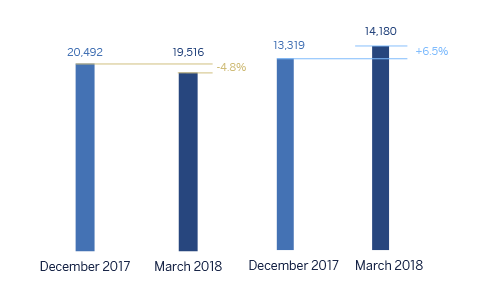Risk management
Credit risk
At the close of the first quarter of 2018 BBVA Group's risk metrics continued to perform well:
- Deleveraging of the credit risk in the quarter (down 1.7% at current and 1.3% at constant exchange rates), due mainly to Spain. In the rest of geographic areas, there was growth at constant exchange rates: Turkey, up 2.4%; Mexico, up 1.5%; South America, up 1.6%; and the United States, up 0.4%.
- The balance of non-performing loans continued to decline, with a quarterly fall, 4.8% at current exchange rates and 4.1% at constant exchange rates. The positive performance in Banking Activity Spain and Non Core Real Estate stands out; on the other hand, South America (7.7% at constant exchange rates) was impacted by the evolution of some retail portfolios and specific customers, and to a lesser extent, in Turkey (0.4% at constant exchange rates) due to the impact of wholesale customers impairment. Positive performance in other geographies.
- As a result, the Group's NPL ratio improved in the first three months of the year to 4.4% as of 31-Mar-2018, a fall of 16 basis points in constant terms with respect December 2017.
- Provisions increased by 6.5% over the quarter (up 7.3% at constant exchange rates), so the NPL coverage ratio closed at 73%, one percentage point above the figure resulting from the application of IFRS 9 to the figure as of January 1, 2018.
- Lastly, the cumulative cost of risk through March 2018 was 0.85%, 2 basis points down on the figure for 2017.
Non-performing loans and provisions (Million euros)

Credit risks (1) (Million euros)
| 31-03-18(2) | 31-12-17 | |
|---|---|---|
| Credit risks | 442,446 | 461,303 |
| Non-performing loans | 19,516 | 20,492 |
| Provisions | 14,180 | 13,319 |
| NPL ratio (%) | 4.4 | 4.6 |
| NPL coverage ratio (%) | 73 | 65 |
- (1) Include gross loans and advances to customers plus guarantees given.
- (2) Figures without considering the reclassification of non-current assets held for sale.
Structural risks
Liquidity and funding
Management of liquidity and funding in BBVA aims to finance the recurring growth of the banking business at suitable maturities and costs, using a wide range of instruments that provide access to a large number of alternative sources of finance, always in compliance with current regulatory requirements.
A core principle in BBVA's management of the Group's liquidity and funding is the financial independence of its banking subsidiaries abroad. This principle prevents the propagation of a liquidity crisis among the Group's different areas and ensures that the cost of liquidity is correctly reflected in the price formation process.
The financial soundness of the Group's banks continues to be based on the funding of lending activity, fundamentally through the use of stable customer funds. During the first quarter 2018, liquidity conditions remained comfortable across BBVA Group's global footprint:
- In the Eurozone, the liquidity situation is still comfortable and the credit gap stable.
- In Mexico, the liquidity position is sound, despite market volatility. The credit gap has widened, as expected, due to the outflow of deposits corresponding to the seasonal collection at the close of 2017.
- In the United States, the liquidity situation is good. Stability of the credit gap due to the moderate growth in lending.
- The liquidity situation in Turkey is comfortable, with a slight increase in the credit gap as a result of lending growing faster than deposits, spurred to the strong commercial dynamics.
- In South America, the liquidity situation remains comfortable, deposits growing faster than lending, leading to a reduction of wholesale funding.
On the funding side, the long-term wholesale funding markets in the geographic areas where the Group operates continued to be stable. The performance of short-term funding remained positive, in a highly liquid environment.
The entities in the BBVA group carried out the following operations:
- BBVA S.A. completed an issuance of senior non-preferred debt, the Group's second of this type, for €1.5 billion, with a floating coupon at 3-month Euribor plus 60 basis points and a maturity of five years.
- In Mexico, BBVA Bancomer carried out an international issuance of subordinated Tier 2 debt of $1 billion. The instrument was issued at a price equivalent to Treasury bonds plus 265 basis points at a maturity of 15 years, with a ten-year call (BBVA Bancomer 15NC10).
- In South America, BBVA Chile issued senior debt on the local market for an equivalent of €288m, in a variety of issuances with maturities ranging from four to six years.
As a result, the liquidity coverage ratio (LCR) in BBVA Group remained comfortably above 100% in the first quarter of 2018, without including any transfers between subsidiaries; in other words, no kind of excess liquidity levels in the subsidiaries abroad is considered in the calculation of the consolidated ratio. As of March 31, 2018, the LCR stood at 126%. Although this requirement is only established at Group level, the minimum level is easily exceeded in all the subsidiaries (Eurozone, 150%; Mexico, 148%; Turkey, 136%; and the United States, 141%).
Foreign exchange
Foreign-exchange risk management of BBVA’s long-term investments, basically stemming from its franchises abroad, aims to preserve the Group's capital adequacy ratios and ensure the stability of its income statement.
The first quarter of 2018 was notable for the appreciation against the euro of the Mexican peso (up 5.0%) and the depreciation of the rest of the main currencies in the geographic areas where the Group operates: the U.S. dollar down 2.7% and the Turkish lira down 7.2%. BBVA has maintained its policy of actively hedging its main investments in emerging countries, covering on average between 30% and 50% of the earnings for the year and around 70% of the excess of CET1 capital ratio (which is not naturally covered by the ratio itself). In accordance with this policy, the sensitivity of the CET1 ratio to a depreciation of 10% of the main emerging currencies (Mexican peso or Turkish lira) against the euro remains at around two negative basis points for each of these currencies. Given the geopolitical context, the coverage level of the expected earnings for 2018 has increased to around 70% in Mexico and 50% in Turkey.
Interest rates
The aim of managing interest-rate risk is to maintain a sustained growth of net interest income in the short and medium-term, irrespective of interest-rate fluctuations, while controlling the impact on the capital adequacy ratio through the valuation of the portfolio of financial assets at fair value with changes reflected in other accumulated comprehensive income.
The Group's banks have fixed-income portfolios to manage the balance-sheet structure. In the first quarter of 2018, the results of this management were satisfactory, with limited risk strategies in all the Group's banks.
Finally, the following is worth noting with respect to the monetary policy pursued by the different central banks in the main geographical areas where BBVA operates:
- No relevant changes in the Eurozone, where interest rates remain at 0% and the deposit facility rate at -0.40%.
- In the United States the upward trend in interest rates continues. The latest hike left the rate at 1.75%.
- In Mexico, Banxico's latest increase has left the monetary policy rate at 7.50%.
- In Turkey, there were no changes in the first quarter. Following the rises in 2017, the average funding rate of the Central Bank of Turkey (CBRT) has remained at 12.75%.
- In South America, the monetary authorities continued their expansive policies, lowering rates in Peru (50 basis points), Argentina (150 basis points) and Colombia (25 basis points).
Economic and regulatory capital
Consumption of economic risk capital (ERC) at the close of February 2018, in consolidated terms, was €33,443m, equivalent to a decline over the quarter of 2.8% (down 2.3% at constant exchange rates). The reduction was focused on fixed-asset and fixed-income spread risk, in the latter case due to the reduction of exposure to the risk.
Attributable economic risk capital breakdown
(Percentage as of March 2018)
